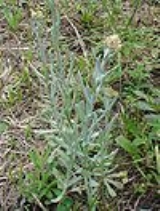
Helichrysum luteoalbum
Encyclopedia
Helichrysum luteoalbum, commonly known as Jersey Cudweed or Weedy Cudweed, is a cosmopolitan weed
.
, under the name Gnaphalium luteo-album (the orthography was later changed to omit the hyphen). In 1829, Ludwig Reichenbach
transferred it to Helichrysum, but this name was not taken up, and the species was retained in Gnaphalium
until 1981, when Olive Mary Hilliard
and Brian Laurence Burtt
transferred it into Pseudognaphalium
.
In 2004, an investigation into the phylogenetic relationships of Helichrysum and related genera found this species to have arisen within Helichrysum. As a result of this, Reichenbach's long-forgotten name for this species was resurrected.
and South America
, and native to every other continent.
Weed
A weed in a general sense is a plant that is considered by the user of the term to be a nuisance, and normally applied to unwanted plants in human-controlled settings, especially farm fields and gardens, but also lawns, parks, woods, and other areas. More specifically, the term is often used to...
.
Description
It grows as an erect herb up to 70 centimetres high, branching from the base. Flowers are cream, yellow, white, or pink.Taxonomy
This species was first published by Carl Linnaeus in his 1753 Species plantarumSpecies Plantarum
Species Plantarum was first published in 1753, as a two-volume work by Carl Linnaeus. Its prime importance is perhaps that it is the primary starting point of plant nomenclature as it exists today. This means that the first names to be considered validly published in botany are those that appear...
, under the name Gnaphalium luteo-album (the orthography was later changed to omit the hyphen). In 1829, Ludwig Reichenbach
Ludwig Reichenbach
Heinrich Gottlieb Ludwig Reichenbach was a German botanist and ornithologist.He was the son of Johann Friedrich Jakob Reichenbach, the author in 1818 of the first Greek-German dictionary. He was the father of Heinrich Gustav Reichenbach, equally a botanist and an eminent orchid...
transferred it to Helichrysum, but this name was not taken up, and the species was retained in Gnaphalium
Gnaphalium
Gnaphalium is a genus of flowering plants in the daisy family, Asteraceae. It contains about 120 species, which are commonly called cudweeds...
until 1981, when Olive Mary Hilliard
Olive Mary Hilliard
Olive Mary Hilliard is a noted South African botanist and taxonomist.Hilliard attended Natal University in the years 1943-47 where she obtained an MSc and later a PhD. She worked at the National Herbarium in Pretoria in 1947-48 and was a lecturer in botany at Natal University from 1954 to 1962...
and Brian Laurence Burtt
Brian Laurence Burtt
Brian Laurence Burtt , was an English botanist and taxonomist who is noted for his contributions to the family Gesneriaceae...
transferred it into Pseudognaphalium
Pseudognaphalium
Pseudognaphalium is a genus of flowering plants in the Asteraceae family. Members of the genus are commonly known as cudweeds.Classification of a number of species is disputed between Pseudognaphalium and the related genus Gnaphalium....
.
In 2004, an investigation into the phylogenetic relationships of Helichrysum and related genera found this species to have arisen within Helichrysum. As a result of this, Reichenbach's long-forgotten name for this species was resurrected.
Distribution and habitat
This species is so widely distributed that it is unclear where it is native and where naturalised. In general it is considered naturalised in NorthNorth America
North America is a continent wholly within the Northern Hemisphere and almost wholly within the Western Hemisphere. It is also considered a northern subcontinent of the Americas...
and South America
South America
South America is a continent situated in the Western Hemisphere, mostly in the Southern Hemisphere, with a relatively small portion in the Northern Hemisphere. The continent is also considered a subcontinent of the Americas. It is bordered on the west by the Pacific Ocean and on the north and east...
, and native to every other continent.

